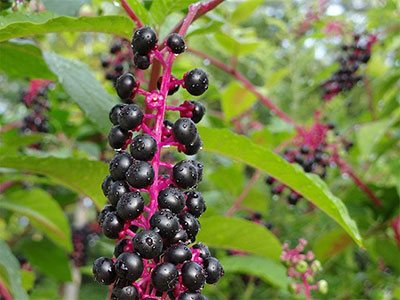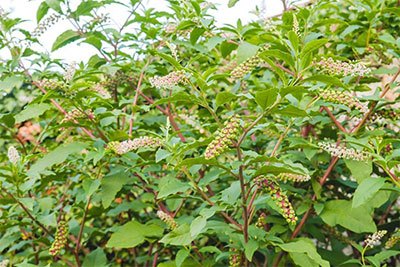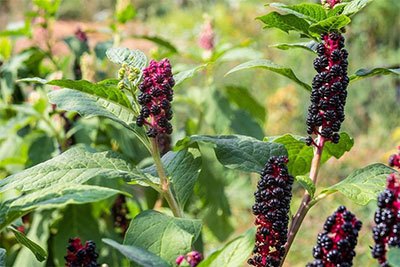Do you have pokeweed in your garden? If you do, then you need to remove them because they can be quite invasive and even toxic. After dealing with the same problem last month, I’m going to teach you how to get rid of pokeweed.
Pokeweed is commonly found in the southeastern United States, but now they’ve been growing incessantly in Pacific Northwest. This perennial herb can start small but can quickly transform into a large bush. If you want to get this weed under control, learn the steps below.
Table of Contents
What do you need to prepare?
1. Gloves
You need a thick pair of gloves to protect your hands from getting accidental cuts and bruises.
Keep in mind that every part of the pokeweed can be toxic to you. For this reason, you need to keep your hands off this plant.
2. Shovel

Larger plants may need a shovel to dig around the roots. This is to pull out the whole root of the weeds. This tool also comes in handy when you dig up some soil to double-check any traces of berries on the ground.
If you don’t have a shovel, you can use a spade or a garden hoe.
3. Soil screen
The soil screen will sift the soil from your yard from any remaining roots of the plant. This can help prevent any further growth of pokeweed in the future.
You can make your own soil screen if you don’t have a soil screen. Simply place a mesh hardware cloth around a wooden frame.
4. Wheelbarrow
A wheelbarrow serves as the place where you’ll screen the soil for any traces of pokeweed roots, stems, or fruits.
If you don’t own a wheelbarrow, you can look for a durable box or a cart. Just make sure that the size fits your soil screen.
5. Rototiller
One way to break up the hard soil is to use a rototiller.
Owning this gardening tool can be pretty expensive, so you can look for alternative equipment, such as a pick mattock or a chisel bar.
6. Garbage bag
You may need a garbage bag to dispose of the pokeweed properly. The last thing you need is to have them regrow in your yard.
If you don’t have a garbage bag, you can use any available plastic bag at home.
7. Optional Items
– Tarp: Pokeweed shouldn’t be thrown while still fresh because they can still continue to grow. What you need to do is to dry the weeds completely. For this reason, you’ll need a tarp to dry the weeds out. If you a cemented ground, you can use it instead of a tarp to lay out the weeds under the sun.
– Water: You may need some water to make the soil moist if it’s hard for you to pull the plant up. For easy application, you can use a water hose to spray water on the affected soil.
– Glyphosate herbicide: You may need to resort to using an herbicide to get rid of persistent pokeweed. What I use is Glyphosate which is safe to use if you follow the instructions on the label. This herbicide works by inhibiting an enzyme that’s important to weed growth. If you can’t find any glysophate herbicide anywhere, you can use other herbicides like 2,4 D and dicamba.
- Rainproof in 2 hours
- Visible results in as little as 2 to 4 days
- Contains 41-percent glyphosate
- Covers over 25,000 square feet
- Makes up to 85 gal. of ready-to-use spray. Note: Packaging may vary
Step-by-step Instructions on How to Get Rid of Pokeweed
1. Pull out new shoots by hand
With your gloves on, begin by digging up any new shoots. Imagine pulling carrots from the ground and firmly grabbing the base of the plant. You’re doing it right if you see a thick taproot with a smaller root emerging from the soil.
Try watering the soil for a few hours before doing this task if you find it hard to pull out the new shoots.
The water will moisten the hard ground making it easy for you to pull out the weeds.
2. Remove larger pokeweed plants
Now, larger plants may be difficult to pull up by the base. You need to dig around the plant to loosen the whole root to a depth of about 12 inches. Use a shovel or a spade to make this job easier.
You might need to make a hole deeper if the root still can’t be pulled out. Remove the whole root from the hole so the plant won’t grow back quickly.
Place the discarded plants in the tarp or cemented ground and let them dry under the sun.
3. Loosen and screen the soil

Sometimes, some small roots will be left on the ground. For this reason, you need to loosen and screen the soil.
Position the soil screen on top of the wheelbarrow and start loosening the soil using a rototiller. Loosen only the area where the plant grew and dig at least 12 inches deep inside the circular hole.
Use a shovel to collect the soil and place it through the soil screen. Try looking for any traces of berries, stems, or small roots. If you found one, place them on the tarp or the cemented area to dry out.
4. Dispose of pokeweed plants properly
Once the pokeweeds are dried out completely, you can put them in a garbage bag and throw them in a waste bin.
Don’t throw them over to the side because they’ll likely grow in that area. Also, avoid throwing fresh pokeweed plants because they can still grow.
5. Monitor regularly

You may need to monitor the areas where the pokeweeds have grown. If you see some young ones, pull them out right away. It may take a couple of years to get rid of this problem fully.
For persistent problems, use a 2% solution of glyphosate herbicide. Simply mix 2-2/3 glyphosate per one gallon of water. Apply the solution to the leaves and pull them up after ten days.
PRO TIP
– When pulling the pokeweed out, make sure that no shred of the root remains, or they’ll keep coming back.
– Pokeweeds are easier to eradicate early in the season before the roots become humongous.
Final thought
Did you enjoy following this tutorial on how to get rid of pokeweed? I hope that you have found success with these instructions so you can grow your plants beautifully.
In my own experience, I have a hard time controlling the pokeweed, but thanks to these solutions, I can already have a nice garden.
Have you tried removing some pokeweed in your yard? If you have, share with us your solutions in the comments section.
Please share this article with your friends if you like it.








I have poke weed and plan to rid my yard of it this fall. Thanks for your comments on
how to successfully take care of this problem
Thank you so much! I just found a huge plant outside my dog’s pen which grew into. Had never heard of or seen it before. Very happy to know how to safely get rid of it.
Hi I live in a very rural area and have no means to trash the pokeweed bc the company refuses grasses and kitty litter.
Can I burn the pokeweed remnants in a burn pit?
Thanks
I moved to rural South central KY last winter but found out about Pokeweed in the ljust a few days ago. Thank you for the information on the proper way to handle this monster of a weed. I finally figured out what gave me contact dermatitis almost 2 1/2 weeks ago. Funny thing is that I had this same type of outbreak 2 years ago after weeding an area in this yard that was Dad’s overgrown yard then, and my newly acquired yard since last December. Back then I went to the doctor almost 4 weeks after the first contact. It had spread from one spot that I thought was a spider bite initially, to a crazy itchy patches all over that and the doctor told me was poison ivy. I had never had poison ivy before so I figured that I had just been lucky my 50+ years despite being “in the weeds kinda kid” and a “get my hands in the dirt kinda gardener”. I had seen the weed but didn’t know anything about this weed’s toxicity before 2 days ago. I assumed it was just KY’s version of a milkweed. I didn’t know what it was until I finally saw a reference to it in a local online magazine with a picture!!!
I just happened to see it peeking out around the edge of my recently planted, weeded and freshly mulched landscaping, so I grabbed it with my bare hands and pulled at it. The stem broke in my hand so I tossed it into the yard.
I know that it’s the only plant that I touched and the first red bump on my arm came I noticed within 30 minutes with the pinchy feeling like a spider/insect bite so I put benedry itch cream on it.
I didn’t hesitate to wash my hands, thank goodness, since this was as the delivery men were bringing in my new couch and chair. I’m sure I touched things like the screen door, interior door, etc. before I washed my hands. Since learning of the pokeweed, I;ve went around and washed everything that I can think of that I might have touched when I didn’t know I had juice of that monster on my hand. All clothes, hoodies, linens, bedding, my new chair, especially where my arms have touched it, have been washed or wiped down. Calamine lotion is working wonders for the itch, and it appears to be finally drying up. Benedryl itch cream did help with the itch, but didn’t help with the spread.
I”M SO HAPPY to finally know what I’m dealing with. I ‘ve been reading up and know that it has been used for many medicinal reasons and for a long time but this stuff is scary. I know I will need to do a better job of protecting myself, and do more reading on the local plants/weeds.
PLUS I’m sure I will come across pokeweed again since I haven’t taken any of the precautions to kill it correctly, YET. But I WILL!! I now know it could be so much worse. THANKS AGAIN!